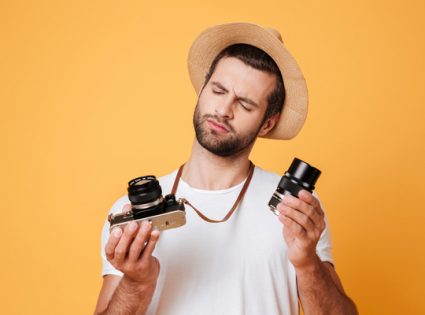3 Secrets to Buying a Great Travel Camera
By Lloyd C | Updated May 21st, 2010

When it comes to casual travel photography, there’s an enormous difference between retail advice, professional advice, and practical advice.
That’s because a typical camera shop employee (or professional photographer) isn’t your typical Globetrooper.
There’s nothing wrong with that, but it means you need to look elsewhere for the type of advice that improves your travel experience.
But no need to fret, we’ve got you covered with our top 3 secrets to buying a great travel camera.
Personally, I don’t travel to take photos; I travel for the life experience. I take photos as an afterthought to help cement the memory of the experience. So even though I want a great camera to capture great moments, I’m not willing to sacrifice the experience for the sake of filling a photo album.
If You Can’t Capture The Moment, There’s No Point Having a Camera
I’m skeptical of large cameras for many reasons:
- I’m a supporter of the carry-on only philosophy, so I automatically want to carry less
- I’m a Globetrooper first and a photographer last, so I don’t want my photography to burden my travel experience
- It’s already difficult to capture great moments, and a larger camera just reduces your chances (especially if it’s not with you because it’s too big for your pocket)
Sure, if you have a large digital SLR camera pointed at your subject, you’ll capture the moment much quicker than if you have a smaller (less powerful) consumer-level camera.
However, I don’t know about you, but I don’t spend my travels sitting and waiting for great photo ops. I suspect that if I did spend my travels sitting and waiting in anticipation, I’d have little to sit and wait for. And the last thing I want is to carry a large bag everywhere I go.
So, more than anything else, I’m a strong advocate of trooping with a single compact camera or even my iPhone camera. There are exceptions (making documentaries, travel by 4×4, commercial photography, etc.), but they’re rare for me.
Megapixels Rarely Matter
If megapixels had no cost (money, weight, other features, etc.) then sure, more is better. But they do have a cost, and in fact, a very high cost.
Most compact consumer cameras don’t have the sensors to produce great pictures at such high resolutions. There are some compact cameras with large sensors and high-megapixel counts, but they’re prohibitively expensive and mostly unnecessary. So there’s always trade off.
With the current line of consumer compacts available, you can either have greater image detail for large prints or better image quality for everything else. As someone who’s never printed a photo, ever, I know which I’d prefer. But oddly, most compact consumer cameras are geared for image detail rather than image quality.
My advice, forget the megapixel count and focus on the camera’s ability to take better pictures more of the time (see next point).
Lens Speed is King
Assuming you have a small camera (that gives you a higher chance of capturing great moments and is less burdensome on your travel experience), the next requirement is image quality. Not the type of image quality that requires more equipment and lots of effort, but the type that is automatic in most situations.
With today’s technology, I believe the biggest factor in ‘taking great pictures with less effort’ is lens speed. And by lens speed, I mean maximum aperture (nothing to do with zooming or startup).
Without boring you (too much), lens speed refers to the volume of light that a camera can handle all at once. Think about a fire hose versus a milkshake straw. The higher the maximum aperture, the lower the film/sensor sensitivity required, which means less noise and higher quality images.
Lens speed has a ton of practical implications: better low-light photography, better action photography, and better everything, really.
Sure, there’s more to great image quality than lens speed, but I’m talking practical advice here. And practically, if you buy a compact camera with good lens speed (there aren’t many), it will have decent glass, decent screen quality, decent features, and more. Again, I may be simplifying things, but we’re Globetroopers, not professional photographers.
What Camera Should I Buy?
Simple. A small camera with a high-speed lens. And most of the time, take your pictures using the Aperture Priority (AP) mode. That means that the camera uses the chosen (usually maximum) aperture while adjusting the other variables (shutter speed, sensor sensitivity, etc.) to get the best result. This generally leads to less noise and better image quality.
Some examples of compact cameras with the fast lens are as follows:
- Panasonic Lumix LX3 (review)
- Leica D-LUX4 (similar to the LX3)
- Canon Powershot S90 (review)
- Samsung TL500 (recently released)
These cameras won’t have all the marketing bells and whistles such as a GPS receiver, which is useless because they take forever to connect to a satellite (unless you leave your camera on all the time). But they are small, they produce great images, and most of them produce decent movies (for their size) too. And that’s all a Globetrooper really needs.
